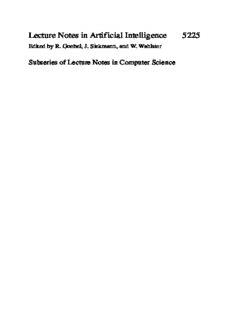Table Of ContentLecture Notes in Artificial Intelligence 5225
EditedbyR.Goebel,J.Siekmann,andW.Wahlster
Subseries of Lecture Notes in Computer Science
Giovanni Pezzulo Martin V. Butz
Cristiano Castelfranchi Rino Falcone (Eds.)
The Challenge
of Anticipation
A Unifying Framework for theAnalysis and Design
ofArtificial Cognitive Systems
1 3
SeriesEditors
RandyGoebel,UniversityofAlberta,Edmonton,Canada
JörgSiekmann,UniversityofSaarland,Saarbrücken,Germany
WolfgangWahlster,DFKIandUniversityofSaarland,Saarbrücken,Germany
VolumeEditors
GiovanniPezzulo
CristianoCastelfranchi
RinoFalcone
IstitutodiScienzeeTecnologiedellaCognizione-CNR
ViaSanMartinodellaBattaglia44
00185Rome,Italy
E-mail:{giovanni.pezzulo,cristiano.castelfranchi,rino.falcone}@istc.cnr.it
MartinV.Butz
UniversitätWürzburg
InstitutfürPsychologie,KognitivePsychologieIII
Röntgenring11,97070Würzburg,Germany
E-mail:[email protected]
LibraryofCongressControlNumber:2008934765
CRSubjectClassification(1998):I.2,I.6,F.1.2,G.3,K.8
LNCSSublibrary:SL7–ArtificialIntelligence
ISSN 0302-9743
ISBN-10 3-540-87701-0SpringerBerlinHeidelbergNewYork
ISBN-13 978-3-540-87701-1SpringerBerlinHeidelbergNewYork
Thisworkissubjecttocopyright.Allrightsarereserved,whetherthewholeorpartofthematerialis
concerned,specificallytherightsoftranslation,reprinting,re-useofillustrations,recitation,broadcasting,
reproductiononmicrofilmsorinanyotherway,andstorageindatabanks.Duplicationofthispublication
orpartsthereofispermittedonlyundertheprovisionsoftheGermanCopyrightLawofSeptember9,1965,
initscurrentversion,andpermissionforusemustalwaysbeobtainedfromSpringer.Violationsareliable
toprosecutionundertheGermanCopyrightLaw.
SpringerisapartofSpringerScience+BusinessMedia
springer.com
©Springer-VerlagBerlinHeidelberg2008
PrintedinGermany
Typesetting:Camera-readybyauthor,dataconversionbyMarkusRichter,Heidelberg
Printedonacid-freepaper SPIN:12531196 06/3180 543210
Foreword
The general idea that brains anticipate the future, that they engage in prediction,
andthatonemeansofdoingthisisthroughsomesortofinnermodelthatcanberun
offline,hasalonghistory.SomeversionoftheideawascommontoAristotle,aswell
as to many medievalscholastics, to Leibniz and Hume, and in more recenttimes,
toKennethCraikandPhilipJohnson-Laird.Onereasonthatthisgeneralidearecurs
continuallyisthatthisisthekindofpicturethatintrospectionpaints.Whenweare
engagedintasksitseemsthatweformimagesthatarepredictions,oranticipations,
andthattheseimagesareisomorphictowhattheyrepresent.
But as much as the general idea recurs, opposition to it also recurs. The idea
hasneverbeenwidelyaccepted,oruncontroversialamongpsychologists,cognitive
scientistsandneuroscientists.Themainreasonhasbeenthatsciencecannotbesat-
isfiedwithmetaphorsandintrospection.Inordertogainacceptance,anideaneeds
tobeformulatedclearlyenoughsothatitcanbeusedtoconstructtestablehypothe-
seswhoseresultswillclearlysupportorcastdoubtuponthehypothesis.Next,those
ideasthatareformulableinoneoranothersortofsymbolismornotationarecapable
ofbeingmodeled,andmodelingisahugepartofcognitiveneuroscience.Ifanidea
cannotbeclearlymodeled,thentherearelimitstohowwidelyitcanbetestedand
acceptedbyacognitiveneurosciencecommunity.Andfinally,ideally,theideawill
be articulatedand modeledin such a way thatit is nota completemysteryhow it
couldbeimplementedbythebrain.Thoughtheideathatthebrainmodelsandpre-
dictsandanticipatesissupportedbyintrospectionandalonghistoryofhypotheses,
ithaslargelyfailedontheselatterthreecounts–especiallycomparedwithvarious
theoreticalcompetitors.And this is whythe extentto which ithas beenembraced
bycognitivescienceandneurosciencehasbeenlimited.
But there is good news. Mathematical tools from a number of areas, including
moderncontroltheoryandsignalprocessing,arecapableofallowingforverypre-
cisemathematicalformulationsofthebasicidea,aswellasmanyspecificversions.
This allows for the ideas notonly to be precisely formulated,but also to be mod-
eledandcomparedtohumanbehavioraldata.Andgivena numberofschemesfor
implementingthesekindsofmathematicalmodelsinneuralsystems,itispossible
VI Foreword
toseethesemodelsasbeingimplementedinthebrain.Thequalitativeideathatthe
brainmodelstheworldisfinallybeingclarifiedandquantified.
But we are still in the early stages of this process. While there are many pro-
posalsandtheoriesthatarebeginningtotakeshape,therehavebeenfewsustained
treatmentsofthetopicthatattempttodevelopthemindetailedandconsistentways.
Rather,theapplicationshavelargelybeenpiecemeal.Inthisregardthepresentvol-
umerepresentsa significantadvanceinthe field.Itoffersa sustainedtreatmentof
variousaspects of the generalhypothesis,notonlyin termsof being conceptually
clearandconsistent,butalso intermsofpresentinga wide rangeof particularap-
plicationsthatillustratetheconceptualmachineryinaction.
Itwouldbeanoverstatementtosaythattheideathatthebrainisamodelerand
predictorisrevolutionary,orthatthecurrentswellintheoreticalinterestintheidea
representstheinitialstagesofarevolutionincognitiveneuroscience.Butwhiletalk
ofrevolutionmaybeoverstatement,itcannotbedeniedthatthisapproachtounder-
standingbrainfunctionisbeginningtotakeonanimportancecomparabletothatof
traditionalartificialintelligenceapproachesandconnectionistmodelingapproaches.
The clarity, detail and quality of the ideas presented in this volume, coupled with
thegrowingimportanceofthisgeneralapproach,makethisvolumeacriticalcontri-
butiontoourunderstandingofbrainfunction,andshouldbereadbyanyonewitha
seriousinterestinunderstandinghowthebrainmanagestosupportcognitivefunc-
tions.
July2008 RickGrush
UniversityofCalifornia,SanDiego
Preface
Predictionisdifficult–especiallyforthefuture.NielsBohr
Over the last few decades, it has become increasingly clear that animals most
of the time do not simply react in their world based on unconditioned or condi-
tionedstimuli,butratheractivelyoperateintheirenvironmentinahighlygoal-and
future-orientedway,andnotjustonthebasisofcurrentperception,butinpartau-
tonomouslyfromenvironmentalstimuli.Psychologynowsuggeststhatitisthegoal
itselfthattriggersbehaviorandattention.Learningishighlyinfluencedbycurrent
predictive knowledgeand the consequentdetection of novelty.Behavioral control
ismosteffectivelycontrolledbythehelpofforwardmodelsthatsubstitutedelayed
orthatenhancenoisyperceptualfeedback.Thus,anticipationscomeinmanyforms
andinfluencemanycognitivemechanisms.
Thisbookproposesaunifyingapproachfortheanalysisanddesignofartificial
cognitivesystems:Theanticipatoryapproach.Weproposeafoundationalviewof
theimportanceofdealingwiththefuture,ofgainingsomeautonomyfromcurrent
environmentaldata,ofendogenouslygeneratingsensorimotorandabstractrepresen-
tations.Weproposeameaningfultaxonomyofanticipatorycognitivemechanisms,
distinguishingbetweenthetypesofpredictionsandthedifferentinfluencesofthese
predictionsonactualbehaviorandlearning.Doingso,wesketchoutanew,unify-
ing perspective on cognitivesystems. Mechanisms, that have often been analyzed
inisolationorhavebeenconsideredunrelatedtoeachother,nowfitintoacoherent
wholeandcanbeanalyzedincorrelationtoeachother.Learningandbehaviorare
considered increasingly intertwined and correlated with each other. Attention and
action control suddenly appear as very similar processes. Goal-oriented behavior,
motivationandemotionappearasrelatedandintertwined.
While the revelation of these correlations is helpful for the analysis and com-
parisonofdifferentlearningandbehavioralmechanisms,thesecondbenefitofthe
anticipatoryapproachisthepossibilitytomodularlydesignnovelcognitivesystem
architectures.Thedevelopedtaxonomyclearlycharacterizeswhichaspectsareim-
portant for different anticipatory cognitive modules and how these modules may
interact with each other. Thus, the second benefit of the anticipatory approach is
VIII Preface
thefacilitationofcognitivesystemdesign.Buildingblocksofcognitivesystemsare
proposedandexemplarilyanalyzedindiversesystemarchitectures.Theinteraction
ofthesebuildingblocksthenischaracterizedbytheiranticipatorynature,facilitat-
ing the design of larger, more competentautonomousartificial cognitive systems.
We hope that the proposed anticipatory approach may thus not only serve for the
analysisofcognitivesystemsbutratheralsoasaninspirationandguidelineforthe
progressivelymoreadvancedandcompetentdesignoflarge,butmodular,artificial
cognitivesystems.
Acknowledgments
This work is supportedby the EU project MindRACES, from Reactive to Antic-
ipatory Cognitive Embodied Systems, funded under grant FP6-511931 under the
“CognitiveSystems” initiativefrom the EC. Specialthanksto ourProjectOfficer,
Ce´cileHuet,andtoourProjectReviewers,LolaCan˜ameroandDeepakKumar,for
theirvaluableencouragementandadvice.
July2008 GiovanniPezzulo
MartinV.Butz
CristianoCastelfranchi
RinoFalcone
Contents
PartI Theory
1 Introduction:AnticipationinNaturalandArtificialCognition...... 3
GiovanniPezzulo, Martin V. Butz, Cristiano Castelfranchi, and
RinoFalcone
1.1 Introduction.............................................. 3
1.2 ThePathtoAnticipatoryCognitiveSystems................... 4
1.2.1 SymbolicBehavior,Representation-LessBehavior,and
TheirMergetoAnticipatoryBehavior ................ 5
1.2.2 ThePowerofAnticipation:FromReactivitytoProactivity 6
1.2.3 TheAnticipatoryApproachtoCognitiveSystems....... 6
1.2.4 TheUnitaryNatureofAnticipation................... 12
1.3 AnticipationinLivingOrganisms............................ 12
1.3.1 AnticipatoryNaturalCognition...................... 12
1.3.2 AnticipatoryCodesintheBrain ..................... 15
1.3.3 SimulativeTheoriesofCognition,andTheirUnifying
Nature........................................... 18
1.4 Conclusions.............................................. 22
2 TheAnticipatoryApproach:DefinitionsandTaxonomies .......... 23
GiovanniPezzulo,MartinV.Butz,andCristianoCastelfranchi
2.1 AnticipatorySystems,Anticipation,andAnticipatoryBehavior... 23
2.2 Predictionvs.Anticipation ................................. 25
2.2.1 PredictiveCapabilities ............................. 25
2.2.2 AnticipatoryCapabilities ........................... 31
2.3 AnticipationandGoal-OrientedBehavior ..................... 34
2.3.1 TheAnticipatoryStructureofGoal-OrientedBehavior .. 35
2.3.2 NotAllAnticipatoryBehaviorIsGoal-Oriented........ 36
2.3.3 WhichAnticipationsPermitGoal-OrientedAction?..... 36
2.3.4 The Hierarchical Organization of Anticipatory
Goal-OrientedAction .............................. 37
X Contents
2.3.5 AdditionalElementsofTrueGoal-OrientedBehavior ... 38
2.4 AnticipationandLearning.................................. 39
2.4.1 LearningtoPredict ................................ 39
2.4.2 BootstrappingAutonomousCognitiveDevelopment:
SurpriseandCuriosity ............................. 40
2.4.3 FromWilledtoAutomaticControlofActionandVice
VersaontheBasisofSurprise ....................... 41
2.5 Conclusions.............................................. 43
3 BenefitsofAnticipationsinCognitiveAgents .................... 45
MartinV.ButzandGiovanniPezzulo
3.1 PotentialsforAnticipatorySystems .......................... 45
3.2 PotentialBenefitsofAnticipatoryMechanismsonCognitive
Functions................................................ 48
3.2.1 Effective,Context-BasedActionInitiation............. 48
3.2.2 FasterandSmootherBehaviorExecution.............. 49
3.2.3 ImprovingTop-DownAttention ..................... 50
3.2.4 ImprovingInformationSeeking...................... 51
3.2.5 ImprovingDecisionMaking ........................ 52
3.2.6 ObjectGrounding,Categorization,andOntologies...... 54
3.2.7 SocialAbilities ................................... 55
3.2.8 Learning......................................... 57
3.3 ArisingChallengesDuetoAnticipationsandAvoidingThem .... 60
3.4 Conclusion............................................... 61
PartII Models,Architectures,andApplications
4 AnticipationinAttention ..................................... 65
Christian Balkenius, Alexander Fo¨rster, Birger Johansson, and
VinThorsteinsdottir
4.1 Introduction.............................................. 65
4.2 LearningWhattoLookat .................................. 66
4.2.1 ALearningSaliencyMap........................... 67
4.3 Cue-TargetLearning....................................... 70
4.3.1 CueingbyaSingleStimulus ........................ 70
4.3.2 ContextualCueing................................. 72
4.3.3 FoveaBasedSolution .............................. 72
4.4 AttendingtoMovingTargets................................ 73
4.4.1 ModelsofSmoothPursuit .......................... 75
4.4.2 EngineeringApproaches............................ 76
4.4.3 TheStateBasedApproach.......................... 78
4.4.4 ThePredictionApproach ........................... 79
4.4.5 TheFoveaBasedApproach ......................... 80
4.5 CombiningBottom-UpandTop-DownProcesses............... 81
Contents XI
5 Anticipatory,Goal-DirectedBehavior .......................... 85
MartinV.Butz,OliverHerbort,andGiovanniPezzulo
5.1 ABriefHistoryofSchemas................................. 87
5.2 SchemaApproaches....................................... 88
5.2.1 SymbolicSchemasforPolicyLearning ............... 89
5.2.2 SymbolicSchemasandPredictionforSelection ........ 90
5.2.3 Neural-BasedPlanning............................. 91
5.2.4 NeuralNetwork-BasedDynamicProgramming ........ 92
5.3 InverseModelApproaches ................................. 92
5.3.1 InverseModelsinMotorLearningandControl......... 93
5.3.2 InverseModelsandSchemaApproaches .............. 94
5.4 AdvancedStructures....................................... 94
5.4.1 PredictionandAction .............................. 95
5.4.2 CoupledForward-InverseModels .................... 97
5.4.3 HierarchicalAnticipatorySystems ................... 98
5.5 EvaluationofPredictiveandAnticipatoryCapabilities .......... 99
5.5.1 Schema-BasedSystems ............................101
5.5.2 InverseModelApproaches..........................106
5.6 Discussion ...............................................108
5.6.1 ContrastingPredictiveSystemCapabilities ............108
5.6.2 ContrastingAnticipatorySystemCapabilities ..........110
5.6.3 Integration .......................................112
5.7 Conclusions..............................................113
6 AnticipationandBelievability ................................. 115
CarlosMartinhoandAnaPaiva
6.1 Introduction..............................................115
6.1.1 AnimationandBelievability ........................115
6.1.2 EmotionandExaggeration..........................116
6.1.3 Anticipation......................................117
6.1.4 Anticipation,Emotion,andBelievability ..............117
6.2 RelatedWork.............................................119
6.2.1 OzProject........................................119
6.2.2 EMA............................................119
6.2.3 DuncantheHighlandTerrier ........................120
6.3 Emotivector..............................................121
6.3.1 Architecture......................................121
6.3.2 AnticipationModel................................122
6.3.3 SalienceModel ...................................123
6.3.4 SensationModel ..................................123
6.3.5 SelectionModel...................................123
6.3.6 Uncertainty.......................................124
6.4 Aini,theSyntheticFlower..................................125
6.4.1 EmotivectorsinAction.............................125
6.4.2 Evaluation .......................................128
Description:This book proposes a unifying approach for the analysis and design of artificial cognitive systems: The Anticipatory Approach. In 11 coherent chapters, the authors of this State-of-the-Art Survey propose a foundational view of the importance of dealing with the future, of gaining some autonomy from

